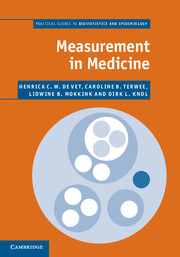Book contents
- Frontmatter
- Contents
- Preface
- 1 Introduction
- 2 Concepts, theories and models, and types of measurements
- 3 Development of a measurement instrument
- 4 Field-testing: item reduction and data structure
- 5 Reliability
- 6 Validity
- 7 Responsiveness
- 8 Interpretability
- 9 Systematic reviews of measurement properties
- References
- Index
3 - Development of a measurement instrument
Published online by Cambridge University Press: 07 September 2011
- Frontmatter
- Contents
- Preface
- 1 Introduction
- 2 Concepts, theories and models, and types of measurements
- 3 Development of a measurement instrument
- 4 Field-testing: item reduction and data structure
- 5 Reliability
- 6 Validity
- 7 Responsiveness
- 8 Interpretability
- 9 Systematic reviews of measurement properties
- References
- Index
Summary
Introduction
Technical developments and advances in medical knowledge mean that new measurement instruments are still appearing in all fields of medicine. Think about recent developments such as functional MRI and DNA microarrays. Furthermore, existing instruments are continuously being refined and existing technologies are being applied beyond their original domains. The current attention to patient-oriented medicine has shifted interest from pathophysiological measurements to impact on functioning, perceived health and quality of life (QOL). Patient-reported outcomes (PROs) have therefore gained importance in medical research.
It is clear that the measurement instruments used in various medical disciplines differ greatly from each other. Therefore, it is evident that details of the development of measurement instruments must be specific to each discipline. However, from a methodological viewpoint, the basic steps in the development of all these measurement instruments are the same. Moreover, basic requirements with regard to measurement properties, which have to be considered in evaluating the adequacy of a new instrument, are similar for all measurement instruments. Chapters 3 and 4 are written from the viewpoint of developers of measurement instruments. When describing the different steps we have the development of PROs in mind. However, at various points in this chapter we will give examples to show analogies with other measurement instruments in medicine.
- Type
- Chapter
- Information
- Measurement in MedicineA Practical Guide, pp. 30 - 64Publisher: Cambridge University PressPrint publication year: 2011
- 11
- Cited by



